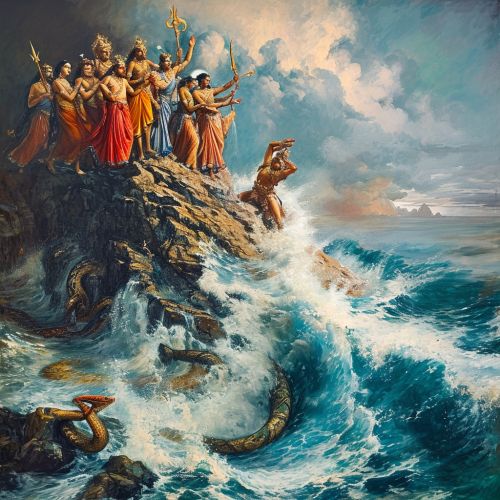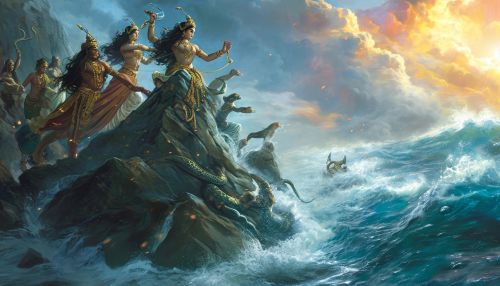Samudra manthan
Introduction
The Samudra manthan or 'churning of the ocean' is a significant episode in Hindu mythology. It is a tale of the gods and demons working together to churn the ocean of milk to obtain the nectar of immortality, Amrita. This event is mentioned in several ancient Indian scriptures, including the Mahabharata, Ramayana, and the Puranas.
The Mythological Tale
The story of Samudra manthan is a symbolic narrative of the struggle between good and evil. It begins with the Devas (gods) losing their strength and power due to a curse from the sage Durvasa. To regain their lost power and immortality, they needed the Amrita, which could only be obtained by churning the Kshirasagara (ocean of milk). The Devas sought the help of their arch-enemies, the Asuras (demons), promising them a share of the Amrita. The Mount Mandara was used as the churning rod, and the serpent Vasuki served as the churning rope. The Devas held the tail of the serpent, and the Asuras held its heads to churn the ocean.


The Churning Process
The churning of the ocean was a colossal task that required immense strength and endurance. During the churning process, several treasures and beings emerged from the ocean, including the divine cow Kamadhenu, the white horse Uchchaihshravas, the divine elephant Airavata, the wish-fulfilling tree Kalpavriksha, the goddess of wealth Lakshmi, and the deadly poison Halahala.
Emergence of Halahala
One of the first things to emerge from the churning was the deadly poison Halahala, which threatened to destroy all creation. To save the universe, Lord Shiva consumed the poison. However, he did not swallow it; instead, he held it in his throat, which turned blue, earning him the name Neelakantha (blue-throated).
Emergence of Amrita
Finally, Dhanvantari, the god of medicine, emerged from the ocean holding a pot of Amrita. A fight ensued between the Devas and Asuras for the nectar. To ensure that the Asuras did not consume the Amrita, Lord Vishnu took the form of the enchanting Mohini and tricked the Asuras, distributing the nectar only among the Devas, thus restoring their power and immortality.
Symbolism
The Samudra manthan symbolizes the spiritual endeavor of a person to achieve self-realization through concentration of mind, withdrawal of senses, control of desires and practice of austerities and asceticism. The Devas and Asuras represent the positive and negative tendencies in every individual. The churning of the ocean signifies the agitation of the mind, and the emergence of the Amrita represents the realization of immortality or the ultimate truth.
Cultural Influence
The Samudra manthan has had a profound influence on Indian culture and spirituality. It is depicted in numerous temples across India and Southeast Asia. The famous sculpture at Bangkok's Suvarnabhumi Airport and the Angkor Wat temple complex in Cambodia are notable examples. The event is also celebrated during the annual festival of Kumbh Mela, where millions of devotees gather to take a holy dip in the Ganges, believed to turn into Amrita during the festival.
